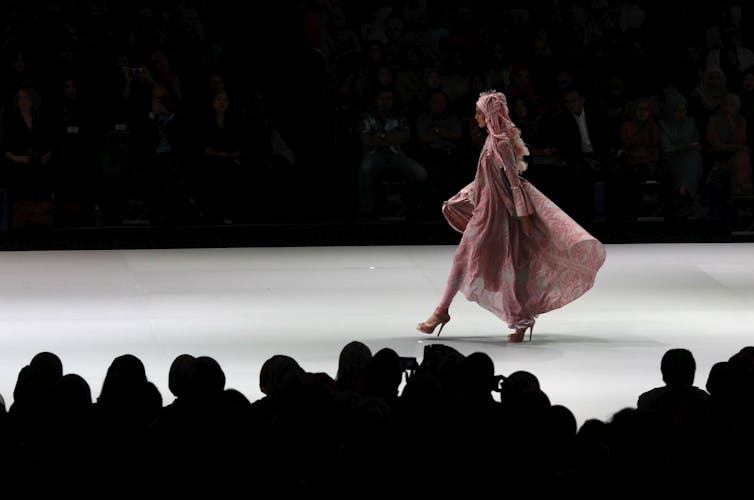the Muslim women challenging stereotypes
It is easy for non-Muslims to forget that there are places where Muslim women lead lives full of frivolity and fun: they shop, read fashion magazines and travel to Europe. But on social media a global community of fashion-conscious Muslim women are challenging the stereotypes of Muslim women as submissive and disempowered.
In Indonesia, where Instagram is one of the fastest-growing social media platforms, these so-called hijabers are creating an image of the ideal, modern Muslim woman. She observes the strictures of the Quran, but is active and visible in the world on her own terms.
The Muslim fashion industry has developed especially quickly in the last couple of decades. From its roots in Turkey, in recent years the hijabers phenomenon has become very much a part of the culture in our region.
In 2010, prominent Indonesian Muslim fashion designers Dian Pelangi, Ria Miranda, Jenahara, and Ghaida Tsuraya established a Hijabers’ Community in Jakarta. In the seven years since then, the Hijabers Community has grown rapidly, sprouting official branches in several major Indonesian cities.

Beawiharta Beawiharta/Reuters
Public Islam
The Indonesian Hijabers Community is part of a broader Islamic-themed consumer culture that has played a growing role in the public life of Indonesia since the early 2010s. Public Islam is an increasingly crowded field, including public intellectuals, tele-preachers, soap operas, boy bands and style leaders, all of whom position themselves in varying degrees of antipathy and affinity to one another. Islamic intellectuals, for example, look down upon tele-preachers.
The hijabers are keen to distance their style of veil from the simpler veils of a bygone era – known as jilbab, a single piece of cloth that covers the head and is secured under the chin with a safety pin. The hijab itself often consists of two piece of cloth – an inner and outer layer – and falls around the shoulders in looser and more layered fashion.
Unlike the jilbab, the hijab is the veil of choice for the well-heeled, style-conscious, creative and assertive Muslim woman. Much more than just a symbol of Islamic piety, the hijab signals a tech-savvy, middle-class Muslim woman who is active and mobile.
Indonesian hijabers have promoted this brand image through social media, print media, hijab-wearing tutorials and face-to-face gatherings. They produce coffee table books filled with photos of glamourous models, and offer expensive courses for budding hijabers to learn the hijab-donning ropes. Quranic recitation and charity events are also part of the network’s activities.
Faith and fashion
In interviews with Alila, hijabers said that they saw conveying Islamic teaching as their primary task as Muslim women. They also said that they thought using Instagram identified them as modern Muslim women.
On Instagram, the hijabers mix together glossy images of Muslim women who travel and work with moral messages inspired by the Quran. In one post, Syifa Fauziah appears looking out the back window of a car, light falling gently across her face, and her chin resting lightly on her perfectly posed hand. The accompanying message reads: “If we don’t fear Allah, who then will we fear?”
Another post on the official Hijabers Community account features three folded prayer mats atop a washing machine, accompanied by a message urging the hjabers to “do good deeds” by taking the prayer mats home from work to give them a wash.
In another, “hpsiswanti” seeks to convey the importance of avoiding activities that distract Muslim women from prayer, by posting an image of herself as a six-armed praying figure, in which two arms are folded in prayer, and the remaining four hold a phone, a remote, a make-up brush and a shopping bag.
In other posts, the hijabers link Quran-inspired messages with international travel and outdoor sport. In one, “pratiwanda” posted a map of Europe, with stars marking the countries she had visited during a backpacking adventure while studying in Leeds. The accompanying message reads: “Allah, please allow me to add other stars as many as possible on Your blessed earth.”
Other posts show Ghina at an archery range, and Irene horse riding. Both images are accompanied by messages that cite a hadith advocating these activities:
Prophet Muhammad SAW [Sall Allahu alay-hi wa-sallam, meaning “may Allah’s peace and blessings be upon him.” It is a standard Muslim expression of love and respect for the Prophet.] said: “Teach your children swimming, archery and horseriding”.
In an interview with Alila, Ghina nonchalantly shared:
I always try to write captions that relate to the Quran, but really the images I post are just about my everyday life.
For some, this after-the-fact addition of Quranic messages onto a register of regular everyday activities might be telling of the shallowness of the hijabers’ religious identities. Indeed, this is a common critique levelled at Muslim women, including the hijabers, who are becoming increasingly visible with the growth of the Muslim fashion industry. Just as Western instagrammers are criticised for being shallow and promoting unrealistic ideals, Muslim women who revel in public attention are often viewed with disdain for linking their faith so closely with shopping and clothes.
But, for us, the hijabers phenomenon, and especially its current Instagram-fuelled chapter, opens opportunities for women to be invested with authority on matters pertaining to Muslim women’s bodies. Far from readying for a clash of civilisations, the hijabers phenomenon signals a world in which Muslim piety is inextricably linked to the global consumer economy.
